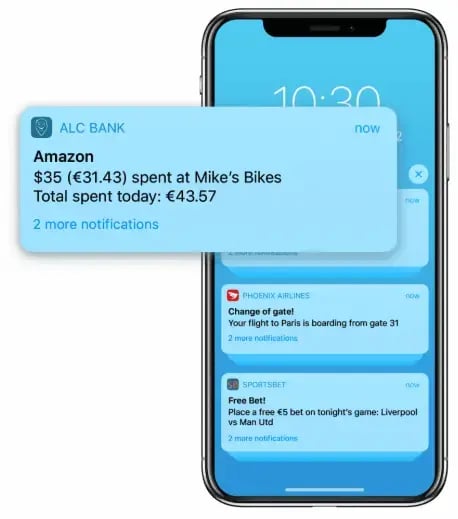Digital Guide
The digital customer engagement channels every brand needs
What is digital customer engagement?
Customer engagement is the sending of messages to both potential and existing customers through one or more of the available digital channels.
These are proactive messages sent to a specific user’s desktop or mobile device and are not to be confused with display advertising or search marketing, which are passive.
An intelligent, multichannel customer engagement strategy is vital, irrespective of your brand’s vertical or business model.
We’ve put together this guide to help you understand the wide range of options out there so that you can identify the right ones for your brand.
The 5 essentials of every digital customer
engagement campaign
Aside from the channel itself, there are five key aspects to a successful digital engagement campaign; personalisation, segmentation, intelligent delivery, a/b testing and automation.
Every digital engagement channel, whether it’s an on-site message, a push notification, an SMS text or an email should have these capabilities.
It’s all about providing the recipient with relevant content at the right time, while ensuring that your delivery systems are optimised.
Personalisation
Personalisation means different things to different people. There’s some uncertainty out there regarding what’s actually possible and how achievable it is at scale.
For some marketers, it goes no further than including the recipient’s first name in the message. That’s certainly one aspect, but true personalisation goes much deeper.
It’s really about using all of the available data you have about your customers, from order details to behavioural patterns and preferred content, to deliver individually relevant experiences.
As consumers, we expect our favourite brands to know more about us, and to use that information to add genuine value to our lives.
In this example on the right, the airline has been able to pull in the customer’s flight details and keep the customer updated accordingly. That’s a perfect example personalisation in action. It doesn’t always have to be about driving sales.

Customer segmentation
If I had to suggest only one thing that could elevate any enterprise’s customer engagement campaigns then it would be better customer segmentation.
Become more accurate with your targeting and conversions will follow naturally.
There’s almost no limit to how granular your segmented lists can be. It all depends on your specific objectives.
Segments are created based on known behavioural data (particular pages visited, app usage, etc) as well as characteristics (nationality, location, age, gender).
The most powerful segments are the ones that combine several pieces of information to create incredibly rich, individually-specific user groups. Once you have these groups, it becomes so much easier to drive business goals.
Let’s say, for example, you wanted to increase your number of monthly active app users.
Rather sending a re-engagement campaign to everyone with the app, you’d want to create a dynamic segment of users who haven’t opened it in two weeks (or whatever time-frame you like).
To give yourself the best chance of re-engaging them, you then further segment that list by a secondary attribute (such as products bought or favourite sport). You can now send these smaller lists personalised, relevant and compelling messages that will have higher engagement rates than a generic blast.
Intelligent and real-time delivery
There are two aspects here; scheduled send time and real-time engagement.
With a sophisticated, data-driven platform behind you, you can be confident that messages are being sent at the optimal times, based on each recipient’s previous behaviour.
You also want to be able to factor in different time-zones to avoid unwanted 3 am alerts that can damage your customer relationships.
One of the most important developments in digital engagement recently is real-time messaging. You need to be able to capitalise on engagement opportunities as they occur. This is true across all verticals, but particularly for brands in publishing and media where being the first source of breaking news stories is crucial.
It’s also vital in the sports betting and gaming industry, where the ability to offer “in-play” betting is a significant competitive differentiator.
A/B testing
Whether it’s the exact wording of an offer (does “sale” or “discount” get more clicks?) or the nature of the promotion (10% off for 24 hours or 20% off for 12 hours?), digital marketers need to A/B test their campaigns to get the best results.
Multivariate testing, as it’s sometimes called, should play a role across all of your digital engagement channels. It’s the only way you’ll be able to optimise your marketing messages for conversions and maximise ROI.
Otherwise, you are relying on your intuition, a.k.a. guesswork. I’m not saying there isn’t a place for that, but it can’t be the principal driver behind your campaigns!
The more you test, the more you learn about both your products and your customers. Which type of products generate the most interest and what type of language resonates strongest with your audience?
These are the kinds of questions that can be answered pretty quickly with a/b testing.

Campaign automation tools
Unless you have a very deep budget for human resources (and let’s face it, no-one does!) then you’re going to need to automate your digital engagement campaigns to achieve results at speed and scale.
Intelligent workflows, built around smart templates allow you to deftly nudge customers towards goal completion time after time. It could be an onboarding or welcome series, intended to drip-feed information at a consistent pace or it might be an abandoned cart recovery campaign that brings users back to the checkout.
The Xtremepush customer journey-builder, Maxautomation, has been designed with multichannel marketing in mind. It allows our clients to efficiently orchestrate otherwise complicated cross-channel campaigns.
One of our biggest clients, Oddschecker, the world’s leading odds comparison website, launched over 100 dynamic campaigns, across 5 channels, over the course of a single week. They were able to do this with a team of just three people. You can read more about our work with Oddschecker here.
The importance of leveraging data to enhance digital customer engagement campaigns
We’re all familiar with the Facebook/Cambridge Analytica mess. It opened our eyes to how our personal data can be exploited.
What the average, honest digital marketer is doing with customer data is not at all the same thing!
There’s absolutely nothing wrong with using customer data, so long as it’s collected openly and fairly, to create better, more personalised experiences for your audience. We’re talking about sending people articles on the things they’re interested in or recommending products that we know they like.
That’s exactly what consumers want.
There’s an obvious requirement for brands to build up robust data repositories. But having the data is only part of the solution, however.
As marketers, we need the data to be easily accessible and actionable. If we aren’t in a position to layer that data into our campaigns and use it to influence our audience towards goal completion then it’s not much use.
We’ve written a guide on dynamic content especially for digital marketers that’s really worth checking out if you’re interested in making use of it in your campaigns.
Website Engagement Channels
We’re going to cover three channels here; web push, on-site messages and the web inbox.
Web pushes are perfect for driving traffic to your website, whilst the other two are used to keep visitors engaged for longer and to create new conversion opportunities.
Web push notifications
Web push is an increasingly important channel for many brands, engaging both “anonymous” website traffic and existing customers with timely, personalised messages.
Have you ever been browsing a website that you like and a prompt appears asking you to “Allow Notifications”? That’s an opt-in message, the first stage in a web push engagement strategy.
Once you have a user’s permission, you can then send them web pushes at any time, even as they browse another website.
If you have a website that’s converting well then you should strongly consider web push as an engagement channel. Each message can be deep-linked, directing the recipient to any page you like.
Similarly, if you’re finding it difficult to remarket to website traffic (maybe you’ve had mixed results with things like Adroll), web pushes give you another chance to engage them. This all depends on getting your opt-in messaging right, however.
We’ve written elsewhere in greater depth about web pushes so if you want to learn all there is know about them, from set-up to practical use cases, we recommend you take a look at that article.
If you are already sending web pushes, then check out this guide we’ve written on creating the perfect web push for eCommerce brands.

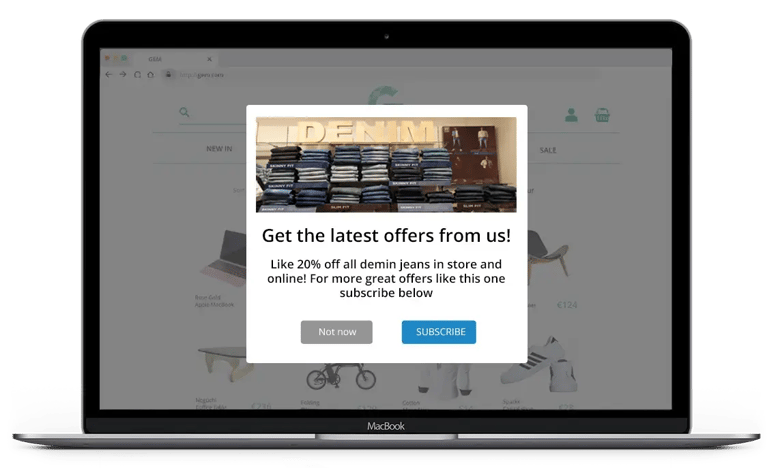
In-web/on-site messages
You are probably familiar with the classic “web pop-up”. They are a common sight on many websites, serving a variety of purposes. They are used to share “similar content” in the middle of a browsing session, promote flash sales or grow an email subscription list.
Up until a few years ago, digital marketers were reliant on providers like Unbounce to launch these highly effective engagement messages. Not only have platforms like Xtremepush made it easier to create an on-site message but they have also vastly enhanced their functionality.
Following a simple SDK deployment (requires minimal input from a developer), you can start sending them straight-away.
One nice detail to note about in-web messages, they do not require opt-in from the visitor.
And they can be triggered by pretty much any on-site behaviour, like the number of page views, specific page viewed and dwell time.
In-web messages give you plenty of creative freedom, supporting large images that can be used to strengthen your marketing message (and there’s not text limit, either). They also support up to two CTA buttons, so you can drive more or less any business objective you have.
Web Inbox
Now, this might be a customer engagement channel you are less familiar with. It’s not all that common, despite its usefulness.
As brilliant as web pushes can be, they disappear once they’ve been engaged with or dismissed (hopefully not too often!). This makes them a less than an ideal channel for evergreen content or offers that last for a long period (like a Summer sale).
So, how do you share these messages with your website visitors?
A web inbox is the answer!
As you can see in the image, an icon is added somewhere prominently on your website. Clicking on it opens up a notification centre. This can be customised to reflect your brand’s colours.
Essentially, this behaves like an email inbox, acting as a place to store all of the push notifications that each user has received from you.
The user doesn’t need to create an account, either, as the Xtremepush platform tracks the profile based on the Device I.D.
It also gives you repeat opportunities to convince visitors to opt-in for web pushes, with a simple on/off toggle that makes it easy without having to go into their browser’s notification settings.
As you can see, the three channels all work very well together, empowering you to reach all of your website’s visitors and nudge them towards goal completion.
Mobile App Engagement Channels
When it comes to driving engagement with your mobile app we have another three channels which are very similar to the ones we’ve just looked at, albeit with some key differences.
Once again, we have push notifications as well as in-app messages and an app inbox.
App push notifications
If you have Whatsapp, Facebook or Twitter on your smartphone then you’ll know all about app push notifications (and if you don’t then how have you managed that?).
These are messages containing information that come, unrequested, from an app alerting you to all manner of content, from likes and shares to sales offers and product updates.
They are an incredibly versatile and effective means of dragging users back into the app and sharing valuable content with them.
If your brand has an app then you need to start sending push notifications. It has to be pointed out though that it’s a permission-based channel. Android users automatically give consent when they download an app, but iOS users must go and do that manually.
But who knows if and when this will change?
In any case, here’s a guide to convincing your app users to opt-in for push notifications.
In-app messages
Can you guess when and where these messages are delivered?
Yes, that’s right, they appear within the app while it’s in use!
We lead the mobile marketing industry in terms of how our clients incorporate this channel into their app engagement campaigns, driving business goals at every stage of the funnel.
We’ve seen them feature prominently during app onboarding and welcome series, but we also work with brands that use them to recover abandoned carts.
One of the big advantages of in-app messaging is that you have several formatting options, depending on the message you are sending. You can choose a subtle banner, or go all out with a full-page takeover.
And you can also be selective with who receives a particular in-app message, segmenting your audience based on any number of attributes and behaviours.
Nearn more about this channel with our guide to in-app messages.


App Inbox
As with its web browser equivalent, this channel acts an inbox which stores messages you send to an app user. You can set an expiry date on the message or mark it as permanent, depending on how time-sensitive it is.
Again, there are a host of business goals that an app inbox can help you achieve. In terms of formatting, you can either choose your service provider’s default template or build a custom one using HTML.
Here’s a more in-depth piece we’ve written on the value of the app inbox and its use cases.
The changing role of email as a customer engagement channel
It wasn’t all that long ago that some analysts were predicting email would be obsolete by 2020.
Emerging brands like WhatsApp and Slack were tipped to replace it, or perhaps a new technology would enter the scene and change everything.
Yeah. No. That hasn’t happened.
Email continues to be a core engagement channel for many brands. Its importance has been diluted, however, that’s certain.
There was a period of a few years when email could be your sole focus, but that’s no longer the case.
It’s is a victim of its own success, perhaps. The beauty of email marketing (its ease-of-entry and potential reach) means that everyone has gotten in on the act. Our inboxes are bursting at the seams, with brands across every vertical competing for opens.
And yet email is here to stay, for the foreseeable future at least.
It’s hardly necessary to go into too much detail about how emails are used to drive customer engagement, as we are all so used to sending them.
However, as a leading email service provider, we know the importance of enhancing your campaigns through segmentation and dynamic, personalised content. These can no longer be seen as “add-ons”, they are vital to ensuring your emails are relevant and add value to your customer’s experience of your brand.
Why SMS could be one of your brand’s most important customer engagement channels
Wait, isn’t SMS dead?
No! Unless you think that an average open rate of 90% is proof of a channel in decline…
We’ve written elsewhere about the value of SMS as part of a multichannel engagement strategy, comparing it to email and push notifications. It’s the perfect complement to all of these other “online-only” channels.
The fact is, people read their SMS messages, and quickly too. 90% of them are read within 3 minutes of delivery. Our email inboxes are saturated, with an overwhelming amount of content being delivered every day.
We also get far fewer SMS texts than we used to, with messaging applications like WhatsApp and Facebook Messenger growing in popularity. So when one is received, it’s noteworthy.
How many unread SMS texts do you have on your phone right now? I’d be willing to bet that for the vast majority of people reading this, the answer is zero. And if there is one or two you haven’t gotten around to opening, then before the day is out I’m certain you will!
We always check it out, even if that’s just to get back to inbox-zero!
Of course, there are limitations to what you can send via SMS. You only have a small number of characters and you can’t include images or videos, but that doesn’t mean you can’t create a compelling, persuasive message.
The importance of consolidating your digital customer engagement channels
There are so many brands on the outskirts of multichannel engagement right now, ready to take the leap. They know the value of it, they’ve read all of the articles about the number of touchpoints a customer has before purchasing and so on.
Something is holding them back, however.
They run email campaigns, they deliver pop-ups, they have an app that performs pretty well and maybe they’ve even started toeing the water with web push.
They might have multiple channels, but that doesn’t make them multichannel!
Why? Because all of their channels are facilitated through separate point solutions. They have no awareness of one another and the data fuelling the campaigns is completely siloed.
One of Xtremepush’s biggest advantages as a platform is that we offer all of the customer engagement channels discussed in this article within a single platform.
There’s a very good reason why; it just makes business sense to run all of your campaigns from a single location. It not only improves their performance but also keeps your costs significantly lower.
Digital marketing executives en masse are looking to consolidate their customer engagement channels. It makes too much sense not to.
There is a perception that this is complicated.
We disagree! And so do our clients.
Typically, the brands we work with are in a position to run huge multichannel campaigns in multiple regions, and sometimes even in multiple languages, within 9 weeks!
Enhancing your digital customer engagement strategy
Your biggest wins are going to come from the channels that can speak to the widest audience, so we recommend starting there.
If you have a website that’s converting well, your goal should be to drive more traffic there. If your mobile app is a core component of the business, let’s get your users spending more time in it.
So focus first on optimisation. Take what’s already working and turn it up to 11! And then gradually layer in additional channels over time. This will allow you to move a lot quicker and start generating ROI immediately.
If you’re wondering what your brand’s next step should be, talk to us.
We’ve been at the cutting-edge of martech since 2014, helping 100s of leading brands across every vertical to enhance their digital engagement campaigns.
Do app and web push notifications need to be used together?
Not at all. Although brands will often use them both as part of their multichannel marketing campaigns, they are separate channels that work independently of one another. It wouldn’t be uncommon for brands to have profiles in their database that can be engaged on both channels, but it is not essential.
Problems can arise if you are using a different service provider for each of them, however. This leads to data silos and in some cases double-messaging. You don’t want to send someone both a web and app push at the same time. That’s why a unified platform that handles both of them is the preferred option, rather than having two disconnected point solutions.
*You do not need an app to send a web push notification!
Web push notifications vs App push notifications: Key differences
Let’s start with the obvious difference. App pushes are linked to, yes, you’ve guessed it, apps! If your brand doesn’t have one then you cannot send them.
Web push notifications are linked to websites and are sent via the browser.
In terms of the user experience, there are some important differences between the two to note.
App Push
• Can only be sent to mobiles
• Can be delivered to mobiles even while in lock mode
• Apps need to be updated and this can lead to drop-offs
• Depending on the device’s operating system, can support rich media
Web Push
• Can be sent to any device that supports web browsers
• The device must be in use
• The user does not need to install anything
• User can receive the push even while browsing another website
How web pushes appear on different devices
As you can see in the image below, there is a significant difference between the appearance of a web push on a Mac and Windows device. Marketers need to take this in account when creating a campaign.
iOS (iPhone) vs Android push notifications
The most important thing to point out here, from the sender’s perspective, is that iOS users must “opt in” (more on how to optimise this later) whereas Android users automatically give permission when they download the app.
If you’re wondering which platform you should focus on, then the answer is both! Here’s a really useful article on global usage and engagement rates.
One area in which Android phones stole a march on their rivals was in regard to rich media (initially just images). It took Apple a little while to catch up but now they are leading the way, allowing brands to include gifs, video and sounds as part of their pushes.
How rich app pushes appear on different devices

How do I send push notifications?
Adding push to your mobile app
Minor differences between the various operating services aside, the steps required to send notifications from your app are pretty much as follows.
- Create push credentials on Firebase and Apple developer consoles
- Add the service provider’s SDK to the app
- Save these credentials in the initialisation of the service provider’s SDK
- Set any other optional configurations for other functionality
- The user will then be prompted to give push permissions (iOS only) on app launch
- Send push messages to the user

How to send a web browser push from your website
You might think that is a complicated process, but it’s relatively straightforward (provided you know what you’re doing). Typically, our development team can get a client’s website ready to send push notifications in a matter of hours.
The steps involved are;
- Add the service provider’s SDK to the site (edit the JavaScript or add with Google Tag Manager)
- Create push credentials on Firebase and Apple developer consoles
- Save these credentials in the service provider’s settings along with an icon for the application
- Set the location that the supporting files are located on the SDK Integration page on the platform, if necessary
- Prompt the user for permission to send them push messages with the service provider’s SDK, ideally from a value exchange or button on the site
- Send push messages to the user
Don’t worry, if this all seems a little beyond your technical capabilities. A good service provider will guide you through it, or even just take care of it themselves!

Can I send push notifications to anyone who has my app or visits my website?
Potentially, yes. There’s a little bit more it than that, however.
Each individual recipient must be “opted in” and have notifications turned on for the specific device. Once again, there are some differences here between app and web browser pushes. And they are differences between phones running on Android and iOS systems too.
As we mentioned earlier, when an Android user downloads an app, they automatically consent to receiving pushes from it. iPhone users must actively give permission to each app.
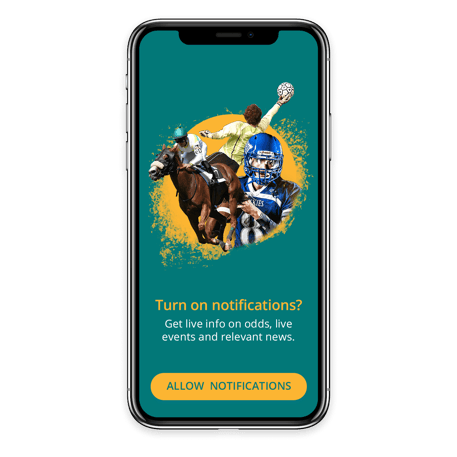
Convincing users to opt in for push notifications
You’ve probably been asked to opt in at least once today already!
It’s a vital part of the process and one that you don’t want to get wrong, as it will undermine your brand and lessen the reach of your campaigns. One of the classic errors that people make is sending the opt-in request too soon.
How many times have you visited a website for the first time, or just opened a newly downloaded app, only to be immediately asked if you want to receive regular updates?
I’ll bet that more often than not you say no, or “maybe later”. Why should you give permission straightaway? You haven’t had time to a) find the information or complete the task you had in mind and b) the brand hasn’t yet communicated its value.
Let’s just linger on that last word a little bit longer, “value”. We talk about the “value exchange” here when devising an opt-in strategy with new clients. It’s an important principle that should never be overlooked.
Fundamentally, if you want to convince more users to opt in, you must be able to answer the following question; what’s in it for them? It’s very clear what the brand’s reward is in the exchange, but you want to make sure the user is satisfied with what they’ll be getting out of it.
If you’re interested, you can read more about app-specific strategies and best practices in this article.
We’ve also written this guide to help you get more opt-ins for web push notifications too!
Why is sending push notifications a good idea?
The short answer? Because they work. Brands that send pushes see increases in engagement rates as high as 85%.
They can be used to achieve a wide variety of business goals and are a highly effective means of sharing valuable content with your audience on their preferred device.
Real-time event triggers
This is perhaps the biggest appeal. It’s a chance to engage your audience as they are using the device. Contrast that to an email, where it could be hours before the recipient sees it, if at all.
App and web push campaigns can be triggered by actions or behavioural patterns and delivered to the user in real-time. This allows you to capitalise on engagement opportunities as they occur. Each notification can be deeplinked to a specific page within the app or on your website.
Dynamic content
When personalising a message with the recipient’s name (whether it’s via email, sms or a push notification), that information is pulled from the profiles stored in your marketing platform. Dynamic content refers to continuously updated information that is pulled in from an API (application programming interface) or your own server. There’s no limit to the types of information that can be pulled in, but common examples include live score updates, weather reports and breaking news stories.
Cost efficient
Compared to the cost of an sms message, the most similar channel in terms of immediacy, push notifications are relatively inexpensive. This makes them ideal channels for reaching a huge volume of users and generating ROI.
Best practices for effective push notifications
They need to be relevant to the recipient
Our CEO, Tommy Kearns, is fond of the following saying, “Success leaves clues”.
Let’s think back to earlier when we looked at the history of push notifications.
Why were they so popular amongst BlackBerry’s users? Why weren’t they clamouring to opt out or turn them off?
The answer is obvious.
I don’t mean to be flippant, but BlackBerry wasn’t sending its users notifications about other people’s emails, were they?
What’s the learning here? Push notifications, on any device, must be relevant to the recipient. The brands who have success with pushes are the ones who have the technical resources to first acquire sufficient customer data and secondly, to put it to proper use.
This goes beyond adding the customer’s first name by the way. I’m talking about knowing which pages of your website they’ve visited and for how long. It’s about leveraging the information you have about their purchase history so that you don’t send a push that’s selling the same thing they’ve recently bought. (How often has that happened to you?)
If you were in the sports betting and gaming industry you’d want to know which types of bets or games each user likes to play so that you can let them know what’s available in those categories.
This is how you ensure your pushes add value to a customer’s experience, instead of irritating them and damaging your relationship.
If you follow this advice then the worst possible response your push notification will get is “I won’t engage with this now, but maybe later”.
Why personalised push notifications matter
The days of “Dear customer” are past. The modern consumer expects the brands it chooses to know more about them.
And it’s worth it. A notification with personalised content is 4 times more likely to be engaged with, compared to a generic message.
Personalisation goes beyond using the customer’s name, however. It’s also about understanding their interests and demonstrating an awareness of their purchase history and interaction with your brand.
The image on the right is a very simple example of how a customer’s data can be leveraged to create a more impactful engagement.

What’s the best time to send a push notification?
There’s no simple answer to this question, unfortunately! It comes down to the purpose of the message, the industry and relevancy of the content.
For some brands, they might find that campaigns sent in the early hours, hoping to catch people on their morning commute, work best. For others, their notifications might be a welcome relief from the boredom of work. You won’t know for sure unless you are running A/B tests and continuously for marginal gains.
Some marketers have a concern that pushes run the risk of over messaging their userbase. And this is indeed a possibility This only happens if you are not creating segments and send generic, irrelevant content.
While we’re on that subject, proper segmentation is vital if you want to create a successful one to one marketing campaign.
So long as you make sure the messages add value to your customer’s online experience you’ll be fine!
If you want to read about this topic in more detail, we have written an in-depth guide on when brands should send app push notifications.
Do users want to receive push notifications?
As they are permission-based, the user has complete control over the notifications they receive. It’s very straightforward to turn them off or opt out, so if they haven’t done this for your brand then it’s natural to assume they want to hear from you. See how push notifications compare to SMS and email here.
Unsurprisingly, in terms of opt-ins, social media leads the way, with users keen to hear about who has followed, shared or like them. News apps also perform well here, especially when the brand can segment and target users based on individual interests.
Brands in other verticals can have a harder time convincing users of their pushes’ value. It’s vitally important that they get the “value exchange” right.

5 main purposes of push notifications
Welcome campaigns
70% of people who download apps are inactive after just three days. Their initial impressions of and experiences with the app must be good if you want them to form lasting engagement habits.
A cleverly mapped-out welcome campaign, automating app push notifications that direct users towards its most valuable and useful features (from a user’s perspective) will go a long way towards achieving this goal.
The goals are much the same for that first couple of web pushes; make the user aware of your most valuable content and perhaps even offer them a welcome discount on selected products.
In general, you want to get them into the sales cycle as soon as possible, whatever form that takes for your business model.
Sales and promotions
As we noted earlier, push notifications don’t actually require the user to be engaging with your website or app to receive them. This makes them ideal channels to promote sales and share the latest deals with your database.
In this example, a web push, the content has been personalised with the exact offer taking into account Simon’s previous purchase history. Naturally, push notifications are ideal channels for ecommerce brands.
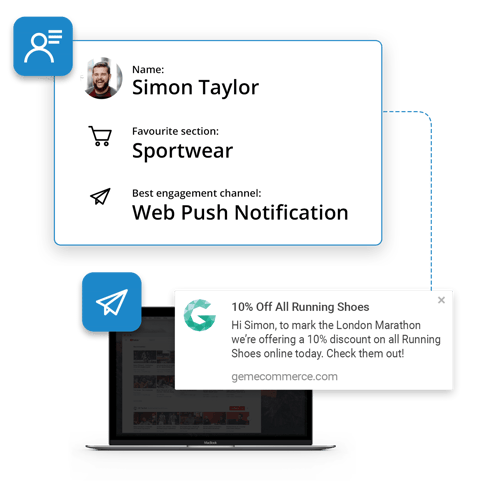
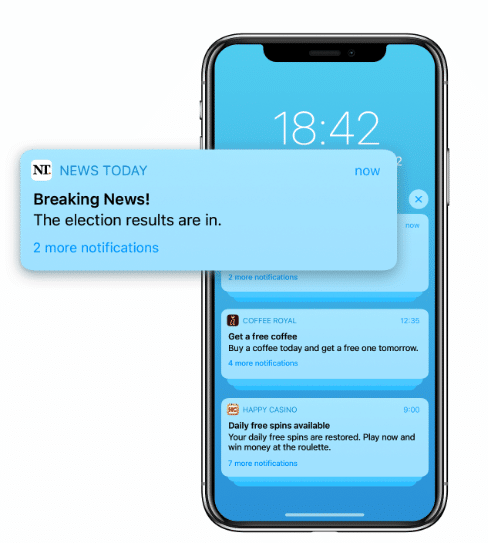
Customer education
Depending on your brand’s business model and vertical, you may not actually be selling anything at all. It could be that you are providing a service, or want to let your users know about a product update or some other crucial, relevant piece of information.
Once again, push notifications are perfect for this.
Transactional messaging and information
This is vital right now in the retail banking industry, for example, where the neo banks like Revolut are shaking things up with an exceptional standard of transactional messaging. We’ve helped a number of tier-one banks roll out automated app push campaigns that provide customers with a real-time record of every transaction in or out of their account.
Across other verticals, the same principle applies. You might want to send your customers notifications about expected delivery times or even ask them for a product review when it has arrived. These pushes can be automated very simply and strengthen the bond between your brand and the customer.
Customer retention
As pushes are delivered instantly to a device as it’s in use, this makes them ideal channels to win back lapsed customers. Nudge users directly to the app or website with a personalised offer that leverages that data you have in your CRM system. Segment users based on the date of their last activity and send a push notification to their preferred device.

Use cases and best practices for push notifications in digital marketing
We think about push notifications as having three distinct, audience-centered goals; acquire, engage, retain. When we begin working with a new client it’s crucial to us that we help them achieve these core marketing objectives.
We’ll cover one use case each for both app and web pushes across all three, but there are plenty more!
Acquisition
App onboarding and first-purchase campaigns (app push)
How many of the people who have downloaded your brand’s app never even got beyond the log-in? (If you don’t have exact figures for this then you are missing out on some very important data)
Across every industry, the average number of app users who don’t complete the registration phase stands at 20%.
When you consider the resources that go into building and promoting an app, it’s incredibly frustrating to see users drop off before you’ve seen any return on your investment.
Of course, there’s plenty of reasons why this happens. Essentially though, it boils down to two; the user either got distracted (maybe even by another push notification!) or they simply didn’t see the point in signing up.
A well-timed, personalised app push can both communicate the value of completing their registration and nudge them back in the app to do so.
In the example here, the user has been given a clear incentive to sign-up and make their first in-app purchase.
We’ve seen brands increase the number of registered, active users by upwards of 10% with push notifications. This in turn creates so many more opportunities to engage your audience and drive business goals.

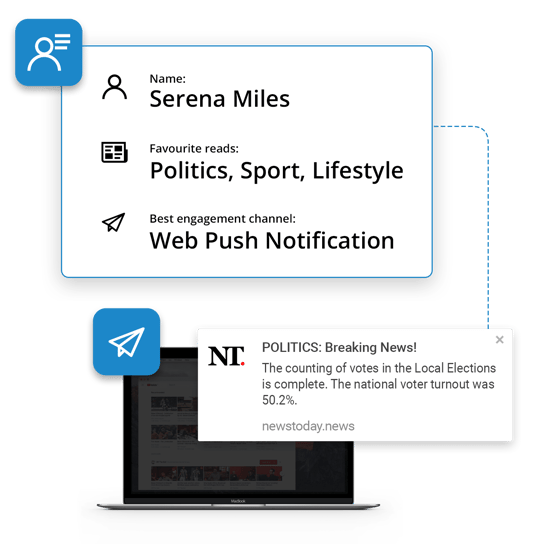
Retargeting website visitors (web push)
You’ve possibly seen this stat batted around, but it bears repeating; only 2% of web traffic converts on their first visit to a site. It begs the question, what’s the best way to re-engage the other 98%?
Maybe you’ve dipped a toe into the world of cookies and retargeted ads. I’d confidently wager you’ve seen very mixed results with that.
How come I’m so sure? The average engagement rate for these ads is .7%. And no, that decimal point isn’t in the wrong place.
Web push notifications perform substantially better. That shouldn’t surprise you too much, after all, as we’ve said, they are permission-based. The recipient wants to be notified. (Provided you are sticking to best practices as we outlined early)
Of course, it will vary from vertical to vertical, but the average CTR for a web push ranges from 10% to 30%. Wouldn’t you take that over .7% every day of the week?
Engagement
Real-time messages (app and web push)
This is something that is becoming increasingly important to sports betting brands, but applies across all verticals (especially publishing and media).
Capitalise on engagement opportunities as they arise and stay ahead of your competitors.

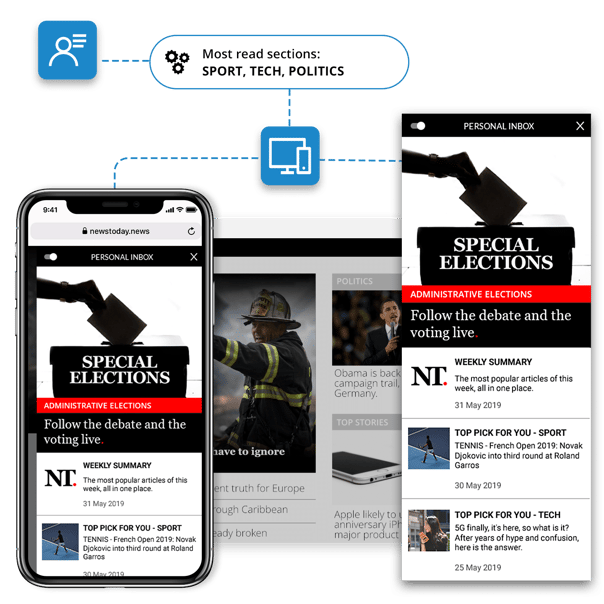
Drive traffic to your website and app
Promote content to your website and app users that you know they are interested in. This is particularly important in the publishing industry, where increasing revenue from advertising is a core business objective. Push notifications, sent at the optimal time to intelligently targeted segments, drive traffic back to the website or app.
Retention
Recovering abandoned carts (app and web push)
I’m struggling to think of an industry that doesn’t have abandonment issues. It’s a digital epidemic, with approximately 70% of all baskets left behind at the checkout.
There’s been plenty written about the reasons why, so we won’t go into that here. Suffice to say, too many customers get cold feet about hitting the purchase button and back out.
So where does that leave you, the brand that’s missing out on all of those sales? How can you win them back?
Push notifications are high-performing options in each of these cases.
They can be deeplinked, directing the recipient back to their pre-populated basket at the optimal time. Which of the two you choose (if you have the option, of course) depends on the device they used to shop and the individual’s preference (based on previous engagement rates).

Re-engaging lapsed users (App and web push)
Despite your best efforts there will always be a certain amount of website visitors or app users that drift away and eventually fall dormant.
In the publishing and media and sports betting and gaming industries, in particular, there is a pronounced risk of churn due to a high volume of competition.
In this example, you can see how intelligent segmentation and personalisation (which we talked about earlier) has been used to ensure the content in each case is relevant to the recipient. This makes them far more likely to win the user back and get them into the sales cycle once again.
Switching Email Provider
If you’ve been reading this article and lamenting the fact that you currently don’t have the ability to execute some, or maybe most, of the tactics we’ve covered then it might be time to think about a new service provider.
It’s a big decision, we know, and marketers are often worried that they may lose data during the migration or have to halt their campaigns.
If you choose a reputable and experienced email vendor then you have nothing to worry about. Check out this guide we’ve written on what to look for and how to prepare when switching email service provider.













